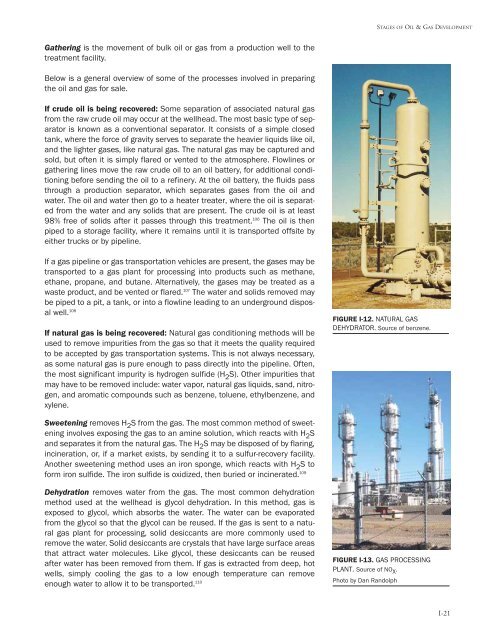Oil and Gas at Your Door? (2005 Edition) - Earthworks
Oil and Gas at Your Door? (2005 Edition) - Earthworks
Oil and Gas at Your Door? (2005 Edition) - Earthworks
Create successful ePaper yourself
Turn your PDF publications into a flip-book with our unique Google optimized e-Paper software.
STAGES OF OIL & GAS DEVELOPMENT<br />
G<strong>at</strong>hering is the movement of bulk oil or gas from a production well to the<br />
tre<strong>at</strong>ment facility.<br />
Below is a general overview of some of the processes involved in preparing<br />
the oil <strong>and</strong> gas for sale.<br />
If crude oil is being recovered: Some separ<strong>at</strong>ion of associ<strong>at</strong>ed n<strong>at</strong>ural gas<br />
from the raw crude oil may occur <strong>at</strong> the wellhead. The most basic type of separ<strong>at</strong>or<br />
is known as a conventional separ<strong>at</strong>or. It consists of a simple closed<br />
tank, where the force of gravity serves to separ<strong>at</strong>e the heavier liquids like oil,<br />
<strong>and</strong> the lighter gases, like n<strong>at</strong>ural gas. The n<strong>at</strong>ural gas may be captured <strong>and</strong><br />
sold, but often it is simply flared or vented to the <strong>at</strong>mosphere. Flowlines or<br />
g<strong>at</strong>hering lines move the raw crude oil to an oil b<strong>at</strong>tery, for additional conditioning<br />
before sending the oil to a refinery. At the oil b<strong>at</strong>tery, the fluids pass<br />
through a production separ<strong>at</strong>or, which separ<strong>at</strong>es gases from the oil <strong>and</strong><br />
w<strong>at</strong>er. The oil <strong>and</strong> w<strong>at</strong>er then go to a he<strong>at</strong>er tre<strong>at</strong>er, where the oil is separ<strong>at</strong>ed<br />
from the w<strong>at</strong>er <strong>and</strong> any solids th<strong>at</strong> are present. The crude oil is <strong>at</strong> least<br />
98% free of solids after it passes through this tre<strong>at</strong>ment. 106 The oil is then<br />
piped to a storage facility, where it remains until it is transported offsite by<br />
either trucks or by pipeline.<br />
If a gas pipeline or gas transport<strong>at</strong>ion vehicles are present, the gases may be<br />
transported to a gas plant for processing into products such as methane,<br />
ethane, propane, <strong>and</strong> butane. Altern<strong>at</strong>ively, the gases may be tre<strong>at</strong>ed as a<br />
waste product, <strong>and</strong> be vented or flared. 107 The w<strong>at</strong>er <strong>and</strong> solids removed may<br />
be piped to a pit, a tank, or into a flowline leading to an underground disposal<br />
well. 108<br />
If n<strong>at</strong>ural gas is being recovered: N<strong>at</strong>ural gas conditioning methods will be<br />
used to remove impurities from the gas so th<strong>at</strong> it meets the quality required<br />
to be accepted by gas transport<strong>at</strong>ion systems. This is not always necessary,<br />
as some n<strong>at</strong>ural gas is pure enough to pass directly into the pipeline. Often,<br />
the most significant impurity is hydrogen sulfide (H 2 S). Other impurities th<strong>at</strong><br />
may have to be removed include: w<strong>at</strong>er vapor, n<strong>at</strong>ural gas liquids, s<strong>and</strong>, nitrogen,<br />
<strong>and</strong> arom<strong>at</strong>ic compounds such as benzene, toluene, ethylbenzene, <strong>and</strong><br />
xylene.<br />
FIGURE I-12. NATURAL GAS<br />
DEHYDRATOR. Source of benzene.<br />
Sweetening removes H 2 S from the gas. The most common method of sweetening<br />
involves exposing the gas to an amine solution, which reacts with H 2 S<br />
<strong>and</strong> separ<strong>at</strong>es it from the n<strong>at</strong>ural gas. The H 2 S may be disposed of by flaring,<br />
inciner<strong>at</strong>ion, or, if a market exists, by sending it to a sulfur-recovery facility.<br />
Another sweetening method uses an iron sponge, which reacts with H 2 S to<br />
form iron sulfide. The iron sulfide is oxidized, then buried or inciner<strong>at</strong>ed. 109<br />
Dehydr<strong>at</strong>ion removes w<strong>at</strong>er from the gas. The most common dehydr<strong>at</strong>ion<br />
method used <strong>at</strong> the wellhead is glycol dehydr<strong>at</strong>ion. In this method, gas is<br />
exposed to glycol, which absorbs the w<strong>at</strong>er. The w<strong>at</strong>er can be evapor<strong>at</strong>ed<br />
from the glycol so th<strong>at</strong> the glycol can be reused. If the gas is sent to a n<strong>at</strong>ural<br />
gas plant for processing, solid desiccants are more commonly used to<br />
remove the w<strong>at</strong>er. Solid desiccants are crystals th<strong>at</strong> have large surface areas<br />
th<strong>at</strong> <strong>at</strong>tract w<strong>at</strong>er molecules. Like glycol, these desiccants can be reused<br />
after w<strong>at</strong>er has been removed from them. If gas is extracted from deep, hot<br />
wells, simply cooling the gas to a low enough temper<strong>at</strong>ure can remove<br />
enough w<strong>at</strong>er to allow it to be transported. 110<br />
FIGURE I-13. GAS PROCESSING<br />
PLANT. Source of NO X .<br />
Photo by Dan R<strong>and</strong>olph<br />
I-21




